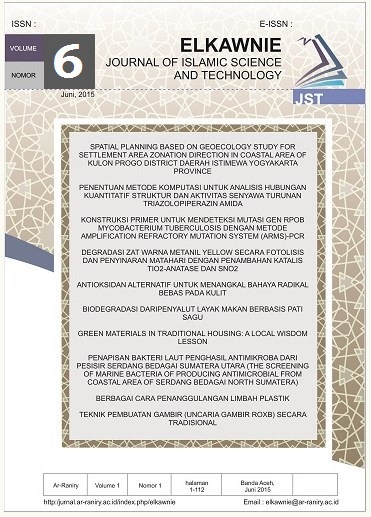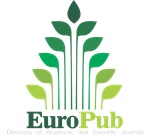The Effect of Applied Voltage in The Electrocoagulation Process of Reducing Pond and River Water Turbidity
DOI:
https://doi.org/10.22373/ekw.v6i1.5538Keywords:
Electrocoagulation, Applied voltage, Groundwater, Pond, River waterAbstract
Abstract : The study about the effect of the applied voltage to decrease the water turbidity from local pond and river have been conducted. This study aims to investigate the ability of the electrocoagulation process in removing pollutants containing groundwater from the pond and river. The water sample obtained from Dusun I Paya Perupuk Tanjung Pura in Langkat Regency. Indonesia which has been reported having high water turbidity. A copper plate was used as a sacrificial electrode with a specific variation of applied voltage of 6, 9, and 12 Volts. The result showed that applying 9 and 12 volts of voltages were able to reduce 60% and 66% of water turbidity from water pond, respectively. In river water, both optimum applied voltages could reduce approximately 98% of water turbidity. The result indicated that the electrocoagulation process potentially devoted as an alternative way to treat the massive local groundwater.
Abstrak : Penelitian mengenai pengaruh tegangan listrik terhadap penurunan kekeruhan air sumur dan air sungai pada proses elektrokoagulasi telah dilakukan. Penelitian ini bertujuan untuk mengetahui kemampuan proses elektrokoagulasi dalam menghilangkan polutan yang berada di air yang diperoleh dari air sumur dan air sungai. Sampel air diperoleh dari Dusun I Desa Paya Perupuk Tanjung Pura Kabupaten Langkat. Lapisan plat tembaga (Cu) digunakan sebagai elektroda dengan variasi spesifik voltase sebesar 6, 9, dan 12 volts. Hasil menunjukkan bahwa pemberian voltase 9 dan 12 dapat menurunkan kekeruhan air sumur sebesar 60 dan 66%. Pada sample air sungai, pemberian kedua voltase optimum dapat menurunkan 98% dari kekeruhan air. Hasil penelitian mengindikasikan proses elektrokoagulasi berpotensi sebagai sebuah cara alternative untuk mengolah air.
References
Asmadi, Khayan, & Heru S. B. (2011). Teknologi Pengolahan Air Minum. Edisi Pertama, Gosyen Publishing, Yogyakarta, 16 – 31.
Aulianur, R. W. (2013). Perbandingan Metode Elektrokoagulasi dengan Metode Presipitasi Hidroksida untuk Pengolahan Limbah Cair Industri Penyamakan Kulit. Institut Pertanian Bogor, Bogor.
Bambang, H. P., & Mining H. (2010). Pengolahan Limbah Cair Tekstil Menggunakan Proses Elektrokoagulasi Dengan Sel Al – Al. Prosiding Seminar Nasional Teknik Kimia Kejuangan. Pengembangan Teknologi Kimia untuk Pengolahan Sumber Daya Alam Indonesia, Yogyakarta.
Fety, K., & Yogi S. (2011). Teknik Praktis Mengolah. Laskar Aksara, Bekasi, Jawa Barat, 9 – 11.
Hendrawati, Delsy, S., & Nurhasni. (2013). Penggunaan Biji Asam Jawa (Tamarindus indica L.) dan Biji Kecipir (Psophocarpus tetragonolobus L.) Sebagai Koagulan Alami Dalam Perbaikan Kualitas Air Tanah. Jurnal Valensi, 3(1), 23-34.
Moraida H. (2011). Efektivitas Elektroda Tembaga (Cu) pada Proses Elektrokoagulasi Dalam Penjernihan Air Sungai Di Desa Air Hitam Kabupaten Labuhan Batu Utara. Departemen Fisika FMIPA USU, Medan.
Nurul, A. (2014). Studi Proses Elektrokoagulasi Untuk Meningkatkan Kualitas Air Sungai Sebagai Air Baku. Departemen Teknologi Industri Pertanian IPB, Bogor.
Peraturan Menteri Kesehatan Republik Indonesia No.416/MENKES/PER/IX/1990. Syarat-syarat dan Pengawasan KualitasAir. Jakarta
Siringo-ringo, E., Kusrijadi, A., & Sunarya Y. (2013). Penggunaan Metode Elektrokoagulasi Pada Pengolahan Limbah Industri Penyamaan Kulit Menggunakan Aluminium Sacrificial Electrode. Jurnal Sains dan Teknologi Kimia, 4(2), 96-107.
Soemarwoto & Otto. (2003). Analisis Mengenai Dampak Lingkungan.
Gajah Mada University Press, Yogyakarta.
Sunardi. (2007). Pengaruh Tegangan Listrik dan Kecepatan Alir Terhadap Hasil Pengolahan Limbah Cair yang Mengandung Logam Pb, Cd, dan TSS Menggunakan Alat Elektrokoagulasi. Seminar Nasional III SDM Teknologi Nuklir, Yogyakarta.
Suparman, Agus R., & Harsunu P. (2016). Penggunaan Metode Elektrokoagulasi Sebagai Alternatif Pengolahan Air Bersih Tanpa Bahan Kimia. Jurnal Agroteknose, 7(2), 46 – 59.
Tuti, R. (2004). Karakteristik Air Sungai Dangkal Di Wilayah Kartasura dan Upaya Perjenihannya. Jurnal Penelitian Sains & Teknologi, 5(2), 104 – 112.
Downloads
Additional Files
Published
Issue
Section
License
Proposed Policy for Journals That Offer Open Access Authors who publish with the Elkawnie journal agree to the following terms:
a. Authors retain copyright and grant the journal right of first publication with the work simultaneously licensed under a Creative Commons Attribution License that allows others to share the work with an acknowledgement of the work's authorship and initial publication in this journal.
b. Authors are able to enter into separate, additional contractual arrangements for the non-exclusive distribution of the journal's published version of the work (e.g., post it to an institutional repository or publish it in a book), with an acknowledgement of its initial publication in this journal.
c. Authors are permitted and encouraged to post their work online (e.g., in institutional repositories or on their website) prior to and during the submission process, as it can lead to productive exchanges, as well as earlier and greater citation of published work (see The Effect of Open Access).

























